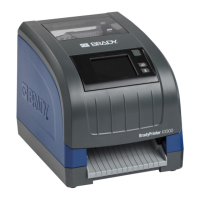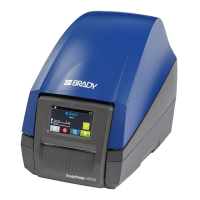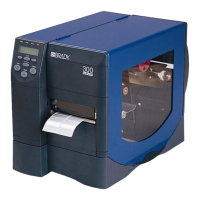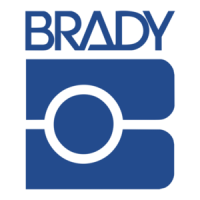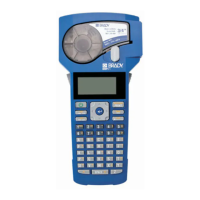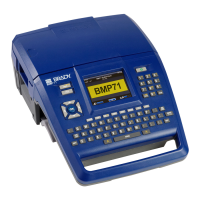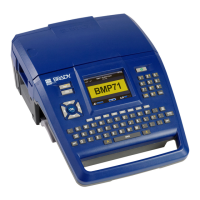Do you have a question about the Brady BradyPrinter i7100 and is the answer not in the manual?
Details EU compliance regulations for electrical equipment and EMC.
Outlines FCC and regional agency approvals, including warnings and compliance statements.
Troubleshooting and guidance via phone or web for printer operation.
Information on depot-based or on-site repair services for the printer.
Global contact information and phone numbers for technical support locations.
Fee-based services for advanced integration and custom programming solutions.
Contact details for inquiries regarding application engineering support.
Explains symbols used for important information, warnings, and notes in the manual.
Defines the proper and improper uses of the device and manufacturer liability.
Crucial safety precautions for operating the printer, including electrical and environmental hazards.
Guidelines for responsible disposal of obsolete devices and battery recycling.
Identifies key components and parts of the BradyPrinter i7100.
Details the available ports and connectors on the printer for various interfaces.
Steps for unpacking the printer and initial setup on a level surface.
Instructions for connecting power supply, computer, or network interfaces.
Procedure for powering on the printer and the system test sequence.
Describes the initial screen and basic operations controllable via touch.
Explains additional symbols that may appear on the start screen based on configuration.
Details the information widgets displayed in the headline of the start screen.
Explains how to navigate through the printer's menu levels and settings.
Detailed steps for loading media from a roll, including positioning and insertion.
Instructions for loading fanfold media into the printer.
Adjusting the printhead locking mechanism for optimal print density.
Procedures for managing rewind, dispense, or tear-off plates for different modes.
Steps for loading the transfer ribbon for thermal transfer printing.
Adjusting the ribbon path to prevent wrinkles and ensure print quality.
Synchronizing paper feed for accurate label positioning and printing.
Describes the tear-off printing mode where labels are manually separated.
Explains the peel-off printing mode for automatic label removal after printing.
Describes the internal rewinding function for winding labels or carrier medium.
General advice and safety precautions for cleaning the printer components.
Specifies approved cleaning materials and part numbers for maintenance.
Procedure for cleaning the print roller to ensure media transport and print quality.
Detailed instructions for cleaning the printhead to maintain print quality.
How to clean the label sensor to ensure accurate label detection.
Shows how error messages are displayed on the printer's screen.
Lists common error messages and provides step-by-step solutions.
Provides solutions for common operational problems and print quality issues.
Specifies dimensions and requirements for various types of label media.
Technical dimensions of printer components relevant to media handling.
Requirements for reflex marks used for media detection.
Specifications for cut-out or notch marks used for media alignment.
Details EU compliance regulations for electrical equipment and EMC.
Outlines FCC and regional agency approvals, including warnings and compliance statements.
Troubleshooting and guidance via phone or web for printer operation.
Information on depot-based or on-site repair services for the printer.
Global contact information and phone numbers for technical support locations.
Fee-based services for advanced integration and custom programming solutions.
Contact details for inquiries regarding application engineering support.
Explains symbols used for important information, warnings, and notes in the manual.
Defines the proper and improper uses of the device and manufacturer liability.
Crucial safety precautions for operating the printer, including electrical and environmental hazards.
Guidelines for responsible disposal of obsolete devices and battery recycling.
Identifies key components and parts of the BradyPrinter i7100.
Details the available ports and connectors on the printer for various interfaces.
Steps for unpacking the printer and initial setup on a level surface.
Instructions for connecting power supply, computer, or network interfaces.
Procedure for powering on the printer and the system test sequence.
Describes the initial screen and basic operations controllable via touch.
Explains additional symbols that may appear on the start screen based on configuration.
Details the information widgets displayed in the headline of the start screen.
Explains how to navigate through the printer's menu levels and settings.
Detailed steps for loading media from a roll, including positioning and insertion.
Instructions for loading fanfold media into the printer.
Adjusting the printhead locking mechanism for optimal print density.
Procedures for managing rewind, dispense, or tear-off plates for different modes.
Steps for loading the transfer ribbon for thermal transfer printing.
Adjusting the ribbon path to prevent wrinkles and ensure print quality.
Synchronizing paper feed for accurate label positioning and printing.
Describes the tear-off printing mode where labels are manually separated.
Explains the peel-off printing mode for automatic label removal after printing.
Describes the internal rewinding function for winding labels or carrier medium.
General advice and safety precautions for cleaning the printer components.
Specifies approved cleaning materials and part numbers for maintenance.
Procedure for cleaning the print roller to ensure media transport and print quality.
Detailed instructions for cleaning the printhead to maintain print quality.
How to clean the label sensor to ensure accurate label detection.
Shows how error messages are displayed on the printer's screen.
Lists common error messages and provides step-by-step solutions.
Provides solutions for common operational problems and print quality issues.
Specifies dimensions and requirements for various types of label media.
Technical dimensions of printer components relevant to media handling.
Requirements for reflex marks used for media detection.
Specifications for cut-out or notch marks used for media alignment.
| Color | No |
|---|---|
| Print technology | Thermal transfer |
| Maximum resolution | 600 x 600 DPI |
| Maximum print height | - mm |
| Minimum print length | 249 mm |
| Maximum printing width | 105.7 mm |
| Display | LCD |
| Control type | Touch |
| Product color | Black, Blue |
| Flash memory | 50 MB |
| Internal memory | 256 MB |
| Wi-Fi | - |
| USB 2.0 ports quantity | 3 |
| Connectivity technology | Wired |
| Maximum label width | 110 mm |
| Operating temperature (T-T) | 0 - 40 °C |
| Quantity per pack | - pc(s) |
| Depth | 460 mm |
|---|---|
| Width | 252 mm |
| Height | 288 mm |
| Weight | 10000 g |
